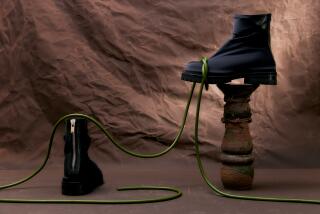Smoking Retains Niche in Fashion World
- Share via
Sometimes, a cigar is just a cigar.
But not when Daryl Hannah is smoking one in Interview magazine while wearing a black teddy and thigh-high boots. And just follow the smoke signals and see who turns up: Paulina Porizkova, with her documented passion for Marlboros, and other models pictured in Taxi and Details magazine, shot smoking on the streets of Paris and in New York nightclubs and cafes.
In an era in which smoking has virtually been stamped out--on airplanes, in the workplace, in theaters--cigarettes are finding a new roost in fashion magazines. Not just in paid tobacco advertising, which has regularly plumped out fashion tomes. Today’s stylish cigarettes are pictured in photographic layouts created by editors who promote fashion and beauty.
The fashionable smoking mis en scene is often shot in black and white, bringing to mind images of such glamorous smokers as Joan Crawford and Lauren Bacall. There is almost a menacingly erotic feeling to the pictures, something run-down around the edges. The women pictured have a vaguely trampy air.
“Since the ‘70s, smoking has been represented as highly individualistic,” says Mark Crispin Miller, associate professor and head of film studies and writing seminars at Johns Hopkins University.
Miller has studied cigarette advertising from its origins in the 1920s through the present and says the cigarette, whether in a fashion or advertising layout, is weighted with meaning.
“Smoking has a strong erotic connotation . . . a cigarette is a sign of sophistication and power,” Miller says.
The first cigarette to specifically target women was Marlboro in 1927, with the slogan “Mild as May.” Prohibitionists first tried to shame the first women smokers out of their habit, but their fight was ineffective as smoking spread widely across American society following World Wars I and II. Today’s Virginia Slims advertising campaign, in fact, is based on contrasting this memory of a punished, repressed early female smoker with a very fashionable modern smoker kicking up her heels.
The ‘40s and ‘50s were smoking’s most glamorous years, with female movie stars smoking their way through films such as “Mildred Pierce” and “Casablanca.” The female smoker was often extremely sexy, with a throaty voice no doubt enhanced by tar buildup. The worldly, jaded smoker handled her cigarette as deftly--and as often--as she did her men.
The party only began to wind down in 1964, when the surgeon general issued a declaration that smoking was dangerous to health. By 1971, all cigarette advertising was voluntarily removed from television, and Americans embarked on an obsessive health craze, running and taking aerobics classes and watching their diets. Many stopped smoking.
Mary Russell, editor in chief of Taxi, says the magazine has routinely featured smokers since the 1 1/2 years of the fashion magazine’s existence. Russell says she has received no complaints from readers.
“Some of our readers smoke, some don’t smoke, and we love our cigarette advertisers. We have absolutely no problem at all with smoking. It’s up to people what they want with their lives. It’s called pro-choice,” Russell says.
Miller argues that the decision to smoke is not an easy, spontaneous one. He thinks smoking is created by the tensions of modern living.
“People smoke when there’s a tremendous amount of pressure,” Miller says. “If working women are smoking a lot, it is because they are under the new pressure of being workers.”
To exacerbate the problem, when they get home they must deal with what Miller describes as a “war of the sexes.”
“A man’s expectations are harder than ever to satisfy,” Miller says. Men resent women working and punish them by withholding affection and emotional support.
“It’s not just the pressure of the job, but the unprecedented difficulty of having an erotic life that makes women smoke,” Miller says.
Poor Paulina.






